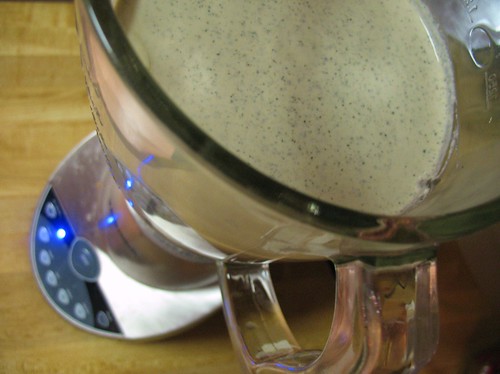I've made a couple attempts at dosas over the years, and nothing had ever turned out like the light & crispy crepe that a good dosa should be. So I scoured the internet for tips and recipes, soaked every conceivable ingredient overnight and began blending up test batches and playing around with technique.
I found two very helpful sites in my quest were Holy Cow! and Manjula's Kitchen These are my absolute favorite Indian blogs and the first stop whenever I'm trying anything new. Holy Cow! had, it seemed, 1001 posts about dosas and I used Manjula's amazing yogurt chutney with the filling of my dosas. If you have any interest in Indian cooking, these blogs are a must read.

Dosa Observations
Dosas take some forethought, as much as three days, as you have to soak the beans, then, possibly, ferment the batter. The batter, in most recipes, is composed of a primary dal, usually urud or moong and a secondary lentil that is combined with rice and blended to form a batter. I tried several combinations and this is what I found:
Primary Dal:
Moong Dal - has a very faint 'pea' flavor and a strong green hue. It has more body than the urud dal. Many recipes use only moong dal, even excluding rice. It doesn't need a secondary bean. The dosa color is a bit strange, though. Adding red lentils or chana might help balance the color.
Urud Dal - I don't like urud dal, but don't be put off by the flavor. It makes a nicely flavored dosa. Fenugreek seed is the flavor perfect complement and the urud flavor fades into the background. It will, however, require more salt than moong beans. I used whole beans for both. The black, urud dal makes a nicely colored dosa.
Secondary Dal:
Chana Dal - This was my preferred choice for the secondary pulse, especially with the urud dal. They gave the batter some needed body and a golden, buttery hue.
Red Lentils - I liked the flavor of the red lentils and they add body, as with the chana dal. I expected a stronger hue, but it was still appealing. I would be happy with either chana dal or red lentils.
Brown Lentils - Plain lentils were dull, with an unenlightened flavor. Use if you must with urud dal, it needs the body, but I greatly preferred both chana dal and red lentils.
Rice:
Brown Rice: I expected a greater color difference. Brown was actually quite similar. Brown rice was not quite as crispy and the flavor wasn't as 'pure.' If you want to add some fiber, go ahead. I wouldn't use more than 50% brown, thought. The dosas will crisp better with white.
White Rice - This had the best results. The rice flavor came through more than with the brown and the dosa was crispier. I will use all white rice in the future.
Ferment:
Many recipes called for up to 24 hours of fermentation, by leaving the batter out an extra day after blending it. This drastically altars the flavor. I made batches completely unfermented, fermented for a few hours and fermented for a whole day. I prefer a few hours of fermentation, but not much more.
I soak the beans overnight, then blend them in the morning, for use in evening. This works well. For a different schedule, I would suggest fermenting for a few hours, then putting the batter in the fridge. Also, the taste is so different, it might be worth trying a fully fermented batter. I think the flavor is a love it or hate it taste. You might love it.
Technique
After a few dosas, I got the technique down. It is important to spread the batter out thinly and quickly. I found that a large soup spoon worked well. I used another spoon to spread oil over the half cooked dosa. I'll post my recipes for Moong Dosas and Urud Dosas this week.
Lobia Chawal
2 days ago





Wow! You've done ALL the research for us! NICE!
Tahn